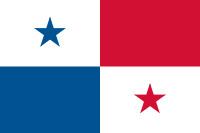Name Bandera de Panamá Adopted on 25 March 1925 Country Panama | Use National flag, Ensign Proportion 2:3 | |
 | ||
Design Divided into four rectangles: the top quadrants are: the white field on the hoist-side bearing the blue five-pointed star in the center and the red field on the fly-side and the bottom quadrants are: the blue field on the hoist-side and the white field on the fly-side bearing the red five-pointed star in the center. | ||
Flag of panama bandera de panama
The flag of Panama was made by María de la Ossa de Amador and was officially adopted by the "ley 48 de 1925". The Panamanian flag day is celebrated on November 4, one day after Panamanian separation from Colombia.
Contents
- Flag of panama bandera de panama
- Bunau Varilla proposal
- Mara de la Ossa de Amador proposal
- Description
- References
The first flag proposed in 1903 consisted of thirteen horizontal stripes of alternating red and yellow, with a blue canton containing two golden suns, joined by a narrow line to depict the oceans to be united by the Panama Canal (see the depiction below). However, this was not accepted by the Panamanian leader, Manuel Amador Guerrero, whose family designed a new flag.
The stars and quarters are said to stand for the rival political parties, and the white for the peace in which they operate. Blue was the color of the Conservatives, and red the color of the Liberals.
Bunau-Varilla proposal
The wife of Philippe-Jean Bunau-Varilla designed the first serious proposal for a Panamanian flag.
Madame Bunau-Varilla's design was based on the flag of the United States, possibly on account of that country's hand in Panamanian independence. Retaining the thirteen stripes, she changed the white stripes to yellow, emphasizing the Panamanian connection to Colombia and Spain (whose flags both prominently feature red and yellow). Mrs. Bunau-Varilla replaced the stars in the blue canton with two interconnected yellow suns; the suns represent North and South America, and are connected because of Panama's position connecting the two continents. Mrs. Bunau-Varilla's proposal was rejected by Manuel Amador Guerrero and his fellow revolutionaries because it was too similar to the U.S. flag, and they therefore gave the task of designing a flag to Guerrero's son.
María de la Ossa de Amador proposal
The current Panamanian flag was made by María de la Ossa de Amador, the first First Lady of Panama, on November 1, 1903. Manuel Amador Guerrero's son, Manuel Encarnación Amador, generally recognized as a skillful drawer, sketched the flag and showed it to María de la Ossa de Amador, who, after much difficulty in avoiding the Colombian army, eventually produced three copies of the flag, which were all eventually flown in Panama City upon independence, and distributed widely.
Description
The Panamanian government officially described the flag in Law 15 of December 1949, as follows: The Flag of the Republic consists thus of a divided rectangle of four quarters: the upper field close to the pole white with a blue star of five points; the upper field further from the pole, red; the lower field near the pole, blue; and the lower one further from the pole, white with a red star of five points.
This flag was to reflect the political situation of the time. The blue was intended to represent the Conservative Party and the red to represent the Liberal Party. The white was intended to stand for peace and purity; the blue star stands for the purity and honesty of the life of the country; the red star represents the authority and law in the country; and together the stars stand for the new republic.
